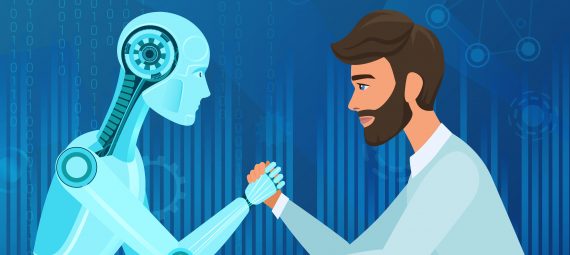A July 2022 report by Acumen Research and Consulting says the global market was $14.9 billion in 2021 and is estimated to reach $133.8 billion by 2030.
68% of survey respondents stated that artificial intelligence (AI) can be used for impersonation and spear-phishing attacks against their companies in the future. (Statista)
69% of enterprise executives believe artificial intelligence (AI) will be necessary to respond to cyberattacks
AI allows defenders to scan networks more automatically, and fend off attacks rather than doing it manually. But the other way around, of course, it’s the same game (David van Weel, NATO’s Assistant Secretary-General for Emerging Security Challenges)
NATO said this year that a cyber attack on any of its member states could trigger Article 5, meaning an attack on one member is considered an attack on all of them and could trigger a collective response.
AI History And Origin
AI has roots in ancient Greek mythology and has been an area of interest in computer science since the 1950s. The first AI program, a checkers-playing computer, was written in 1951 by Christopher Strachey. The field of AI research was founded at a conference at Dartmouth College in 1956, where the term “artificial intelligence” was coined. Since then, AI has advanced dramatically and is now used in a variety of industries and applications, from virtual personal assistants to self-driving cars.
With the introduction of expert systems, which were intended to handle specific issues by reasoning about knowledge, mostly represented as if-then rules, AI research made considerable strides in the 1960s and 1970s. Unfortunately, because to slow advancement and budget reductions, AI went through an “AI winter” in the 1980s. Machine learning, which allowed computers to learn from data and make predictions or judgments without being explicitly programmed, helped resurrect AI research in the late 1980s and early 1990s. Big data and sophisticated algorithms have helped AI make major strides in recent years, with
applications in a variety of industries including medical, banking, and retail. Advancements in
a variety of fields have also resulted from the growth of deep learning and neural networks.
In the 1960s and 1970s, AI research made significant progress, with the development of expert systems, which were designed to solve specific problems by reasoning about knowledge, represented mainly as if-then rules. However, AI experienced an “AI winter” in the 1980s due to limited progress and funding cuts. In the late 1980s and 1990s, AI research was revitalized with the development of machine learning, which enabled computers to learn from data and make predictions or decisions without being explicitly programmed. In the last several years, big data and advanced algorithms have enabled AI to advance
significantly, with applications in a range of sectors like healthcare, banking, and retail. Deep
learning and neural network developments have also enabled advancements in areas like computer vision and natural language processing.
HOW CAN AI HELP IN CYBER SECURITY?
Artificial intelligence (AI) can play a significant role in enhancing cyber security by assisting in various tasks
Tasks such as:
Threat detection and reaction: AI algorithms are capable of analyzing vast volumes of data from numerous sources, such as network traffic, system logs, and security warnings, in order to spot and take immediate action against potential security risks.
Fraud detection: Artificial intelligence (AI) algorithms can be used to examine transaction data and find recurring patterns of behavior that point to fraud. Compared to conventional methods, this can assist in more rapidly and correctly identifying fraudulent behavior.
Malware detection: Even if the malware has never been seen before, AI algorithms can be used to examine files and find those that contain malware.
Vulnerability assessment: AI algorithms can be used to examine software and systems to find potential weaknesses, making it simpler to prioritize and fix the most serious flaws.
Phishing protection: AI algorithms can be used to examine email content and identify phishing assaults, making it simpler to spot and stop these kinds of attacks.
Network security: AI algorithms can be used to examine network traffic and spot potential security risks like malware infections or unauthorized access attempts.
Risk assessment: AI algorithms can be used to analyze and evaluate the risk posed by various cyberattack types, enabling businesses to set priorities and distribute resources.
It’s vital to remember that artificial intelligence (AI) cannot replace existing security measures; rather, it can be utilized to improve them. Organizations must still implement strong security procedures. These procedures include multi-factor authentication, regular software and security system updates, and employee training on security best practices.
What are the advantages and disadvantages of artificial intelligence in Cybersecurity?
Advantages:
- Improved threat detection
- Increased efficiency and speed in analyzing security data
- Ability to identify and respond to attacks in real-time
- Reduction of false positive alerts
Disadvantages:
- High cost of deployment and maintenance
- Potential for false negatives (failure to identify a threat)
- Dependence on large amounts of data for training
- Bias in algorithms and potential for ethical misuse.
AI can be used in various ways for cyber attacks including:
Malware: Attackers can utilize AI algorithms to assess and get around standard security measures, making it simpler for them to transmit malware and access private data.
Network intrusions: AI algorithms can be used to automatically find and take advantage of weaknesses in a target network, making it simpler for attackers to get unwanted access to critical data.
DDoS attacks: AI algorithms can be used to plan and coordinate massive DDoS attacks, making it simpler for attackers to overload and take down targeted websites or online services.
Ransomware: AI algorithms can be used to automatically encrypt sensitive data and demand money to decrypt it, making it simpler for attackers to conduct ransomware assaults.
Fraud detection: AI algorithms can be used to evade traditional fraud detection systems by analyzing patterns of behavior and identifying new, previously unseen patterns of fraud.
Social engineering: AI algorithms can be used to automatically find and take advantage of weaknesses in a person’s psychological profile, making it simpler for attackers to execute social engineering assaults.
We will describe now one example of AI ethical misuse.
AI Social Engineering Attacks & Defense
Social engineering attacks are becoming more and more sophisticated and successful because of the use of artificial intelligence. To deceive people into disclosing private information or taking acts that are harmful to themselves or organizations, social engineering attacks employ psychological manipulation.
Examples of AI-powered social engineering attacks include:
Voice imitation: To increase the credibility of phone-based phishing assaults, AI algorithms can produce lifelike imitations of human voices, particularly those of specific people. In these types of attacks, an attacker may imitate a reputable source, such as a bank or government agency, using a synthesized voice to lure the victim into disclosing private information or carrying out an action, like transferring money.
Chatbots: AI-powered chatbots can be used by attackers to pose as actual people or companies on social media or instant messaging services. The chatbot may try to fool the victim into disclosing private information, such as passwords or financial details, or it may ask the victim to take an action, like clicking on a malicious link.
Email filtering: Attackers can avoid typical spam filters by using AI algorithms to examine email content and determine if the message is trustworthy or not. As a result, it may be simpler for attackers to send phishing emails that seem to be from reputable sources like financial institutions or governmental organizations.
Real human video imitation: Real human imitation may be used in phishing emails to force people to do some action. Similar to the human imitation video in the Czech Republic, where inside the phishing email was a video with a fake bank employee pretending to be real human customer support trying to force the customer to make an unfinished payment with a phishing link redirecting to a fake bank website.
To protect against these types of attacks, organizations can take the following steps:
User education: Workers should be trained to recognize and steer clear of the newest social engineering methods, particularly those that make use of AI.
Strong authentication: Multi-factor authentication can make it far more difficult for attackers to access sensitive data without authorization.
Regular software updates: Keeping security systems and software current can aid in ensuring that vulnerabilities are fixed quickly.
Monitoring and detection: Consistent network and system activity monitoring can aid in the early detection and mitigation of potential social engineering assaults.
If you are looking for more sophisticated types of protection against AI-POWERED attacks then you can try further protection tools including:
Incident response plan: Having a plan in place might help to lessen the harm a successful social engineering assault causes.
Network segmentation: Network segmentation can make it more difficult for attackers to travel laterally through the network and access critical data by dividing it into smaller, more isolated portions.
Access controls: Strict access restrictions can reduce the amount of sensitive data that an attacker can access in the event that their attack is successful.
Penetration testing: By regularly carrying out penetration tests, security vulnerabilities can be found and fixed before they are used by attackers.
It is important to remain vigilant against these types of attacks as they become increasingly sophisticated. When it comes to potential social engineering attacks, especially ones that involve AI, people should be cautious and vigilant. This calls for being on guard for unauthorised requests for sensitive or private information, verifying the legitimacy of emails or phone calls before responding, and avoiding clicking on links or downloading attachments from unauthorised or dubious sources.
For organizations to be successful, they must be aware of the most recent AI-powered cyberattack tactics and have strong security defenses in place. This requires implementing multi-factor authentication, routinely updating software and security systems, and monitoring network and system activity for signs of potential attacks

